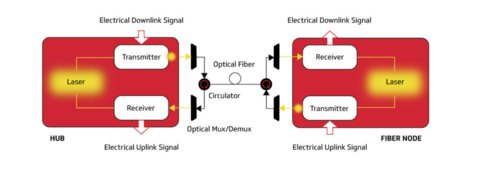A year after launching a Coherent Optics specification that it says can greatly increase capacity of fiber networks, CableLabs released the specification of Full Duplex Coherent Optics.
The technology, the cable industry research consortium says, is designed for access networks with limited fiber strands (one or two from the head end to the node), doubling bidirectional capacity of each fiber. In fact, the capacity of each access network fiber can be increased up to 200 times, CableLabs claims.
“Most cable operators have a somewhat limited fiber count between the headend and the fiber node, so maximizing the capacity provided by this scarce resource has real economic advantages for cable operators,” wrote Steve Jia, distinguished technologist for wired technologies at CableLabs, in a blog post introducing the Full Duplex spec.
Jia included a graphic describing the technology, which is posted here:

Separately, CableLabs has been working on Full Duplex DOCSIS 3.1, a specification it says could deliver bidirectional speeds of up to 10 Gbps over coaxial networks.
RELATED: Q&A—CableLabs’ McKinney on Full Duplex, coherent optics and the 'random choice' of coaxial cable
Jia said that according to recent surveys, 20% of operators use a single-fiber “topology” in their networks, meaning that both downstream and upstream transmission between the head end and the node use a single strand. It’s estimated that the number will grow to over 60% in the next five years.
“Therefore, bidirectional transmission over a single fiber is needed for coherent signals to support single-fiber topologies and to facilitate the redundancy of optical links,” Jia said.
Currently, achieving bidirectional transmission with a single laser requires two fibers, with the single laser in a transceiver functioning as both an optical signal source in the transmitter and as the reference local oscillator single in the receiver.
“Because of the use of the same wavelength from the same laser, a second fiber must be available for the other direction—one fiber for downstream and a second fiber for upstream,” Jia explains.
A “second typical approach,” the technologist added, “is to use a single fiber, but transmit at different frequencies or wavelengths, similar to the upstream and downstream spectrum split that we implement in our HFC networks. To accomplish this frequency/wavelength multiplexing approach, two lasers operating at different wavelengths are needed. Wavelength multiplexers and demultiplexers following a wavelength management and allocation strategy are needed to combine these different wavelengths over the same fiber. The second laser ends up costing a lot more than money—increasing power consumption, operational complexity, and transceiver footprint.”
With the alternative Full Duplex Coherent Optics approach, Jia said, operators “leverage two optical circulators on each end in a special configuration. The circulator is a low-cost, passive, but directional device—much like a traffic roundabout for cars, but this is an optical roundabout. Instead of using two fibers, a single fiber is connected for bidirectional transmission. Most importantly, instead of using two lasers, a single laser is employed for single-fiber coherent systems.”
The Full Duplex scheme, Jia added, can be incorporated into CableLabs’ ongoing Point-to-Point Coherent Optics specification effort, which will be issued in mid-2018. The Coherent Optics effort follows a tripling of CableLabs’ fiber-optics team over the last two years.
“Our work, if you think about it, is really in infrastructure, whether it’s DOCSIS, fiber optics,” CableLabs President and CEO Phil McKinney told FierceCable at SCTE Cable-Tec Expo in Denver back in October.
“Coherent is really about using polarization,” McKinney added. “I can polarize that light, and therefore radically simplify the transport of bits over that cable. The concept is being used in very long-haul kinds of networks. We took it and innovated it around point-to-point, short-haul kind of distance. When you do that, you uncover some unique characteristics. At 80 kilometers, if you do the right approach on coherent, you can radically simplify the electronics on the other end. You can do all kinds of nice things to where you can deliver really high speeds at low cost.”